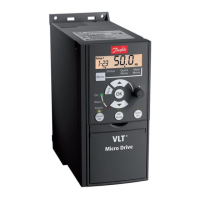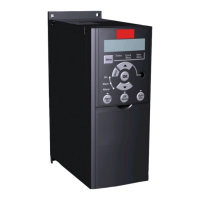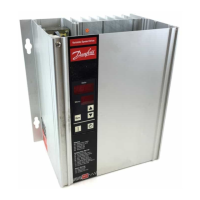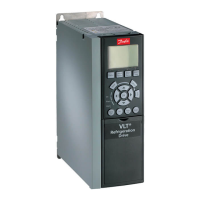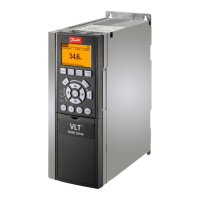Coding System 8-bit binary, hexadecimal 0-9, A-F. Two hexadecimal characters contained in each 8-bit field of the
message
Bits Per Byte 1 start bit
8 data bits, least significant bit sent first
1 bit for even/odd parity; no bit for no parity
1 stop bit if parity is used; 2 bits if no parity
Error Check Field Cyclical Redundancy Check (CRC)
7.8.2 Modbus RTU Message Structure
The transmitting device places a Modbus RTU message into a frame with a known beginning and ending point. This allows receiving devices to begin at
the start of the message, read the address portion, determine which device is addressed (or all devices, if the message is broadcast), and to recognise
when the message is completed. Partial messages are detected and errors set as a result. Characters for transmission must be in hexadecimal 00 to FF
format in each field. The frequency converter continuously monitors the network bus, also during ‘silent’ intervals. When the first field (the address field)
is received, each frequency converter or device decodes it to determine which device is being addressed. Modbus RTU messages addressed to zero are
broadcast messages. No response is permitted for broadcast messages. A typical message frame is shown below.
Typical Modbus RTU Message Structure
Start
Address Function Data CRC check End
T1-T2-T3-T4 8 bits 8 bits N x 8 bits 16 bits T1-T2-T3-T4
7.8.3 Start / Stop Field
Messages start with a silent period of at least 3.5 character intervals. This is implemented as a multiple of character intervals at the selected network
baud rate (shown as Start T1-T2-T3-T4). The first field to be transmitted is the device address. Following the last transmitted character, a similar period
of at least 3.5 character intervals marks the end of the message. A new message can begin after this period. The entire message frame must be transmitted
as a continuous stream. If a silent period of more than 1.5 character intervals occurs before completion of the frame, the receiving device flushes the
incomplete message and assumes that the next byte will be the address field of a new message. Similarly, if a new message begins prior to 3.5 character
intervals after a previous message, the receiving device will consider it a continuation of the previous message. This will cause a time-out (no response
from the slave), since the value in the final CRC field will not be valid for the combined messages.
7.8.4 Address Field
The address field of a message frame contains 8 bits. Valid slave device addresses are in the range of 0 – 247 decimal. The individual slave devices are
assigned addresses in the range of 1 – 247. (0 is reserved for broadcast mode, which all slaves recognize.) A master addresses a slave by placing the
slave address in the address field of the message. When the slave sends its response, it places its own address in this address field to let the master
know which slave is responding.
7.8.5 Function Field
The function field of a message frame contains 8 bits. Valid codes are in the range of 1-FF. Function fields are used to send messages between master
and slave. When a message is sent from a master to a slave device, the function code field tells the slave what kind of action to perform. When the slave
responds to the master, it uses the function code field to indicate either a normal (error-free) response, or that some kind of error occurred (called an
exception response). For a normal response, the slave simply echoes the original function code. For an exception response, the slave returns a code that
is equivalent to the original function code with its most significant bit set to logic 1. In addition, the slave places a unique code into the data field of the
response message. This tells the master what kind of error occurred, or the reason for the exception. Please also refer to the sections
Function Codes
Supported by Modbus RTU
and
Exception Codes.
VLT
®
AQUA Drive Design Guide 7 RS-485 Installation and Set-up
MG.20.N5.02 - VLT
®
is a registered Danfoss trademark
179
7
